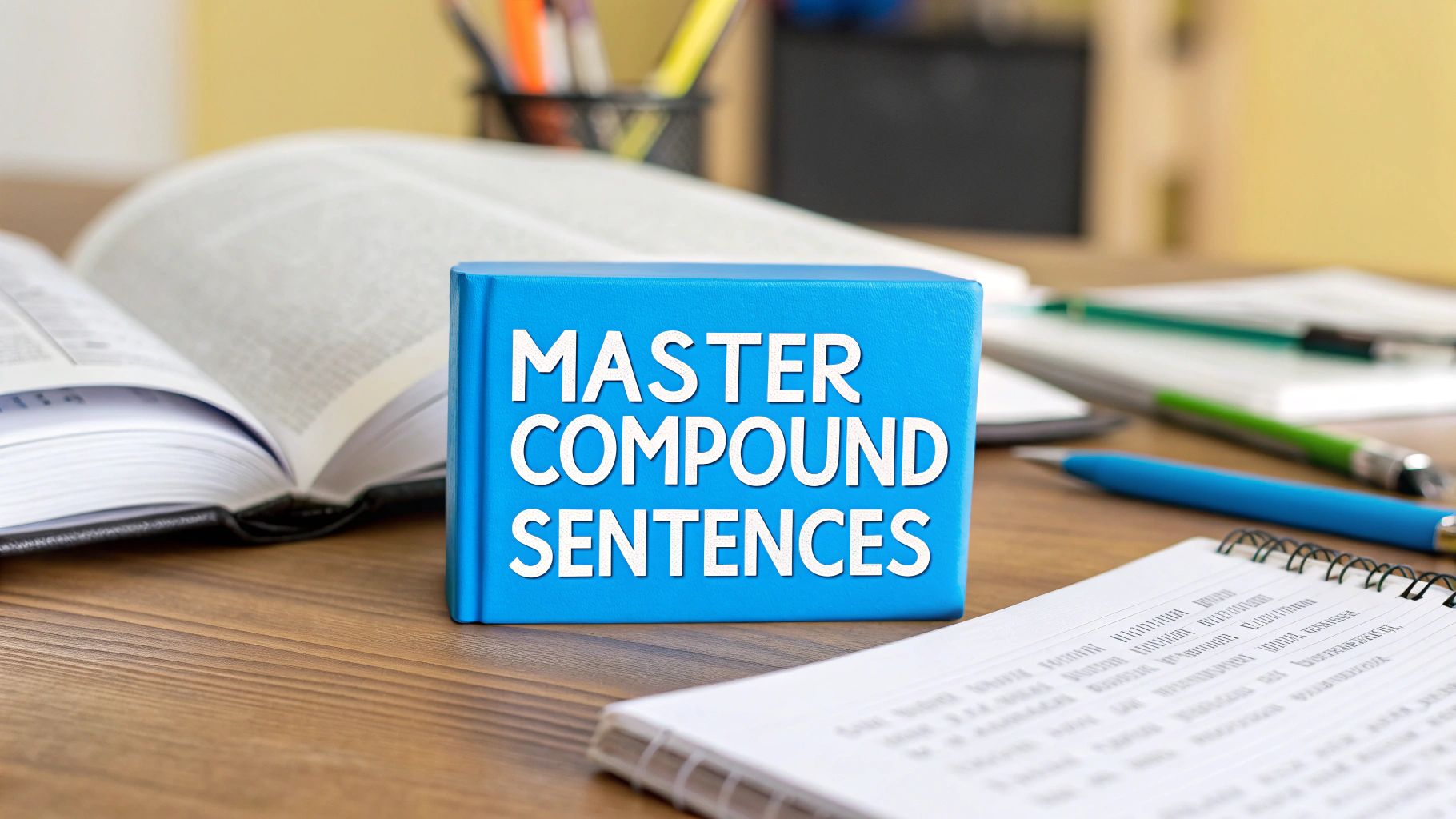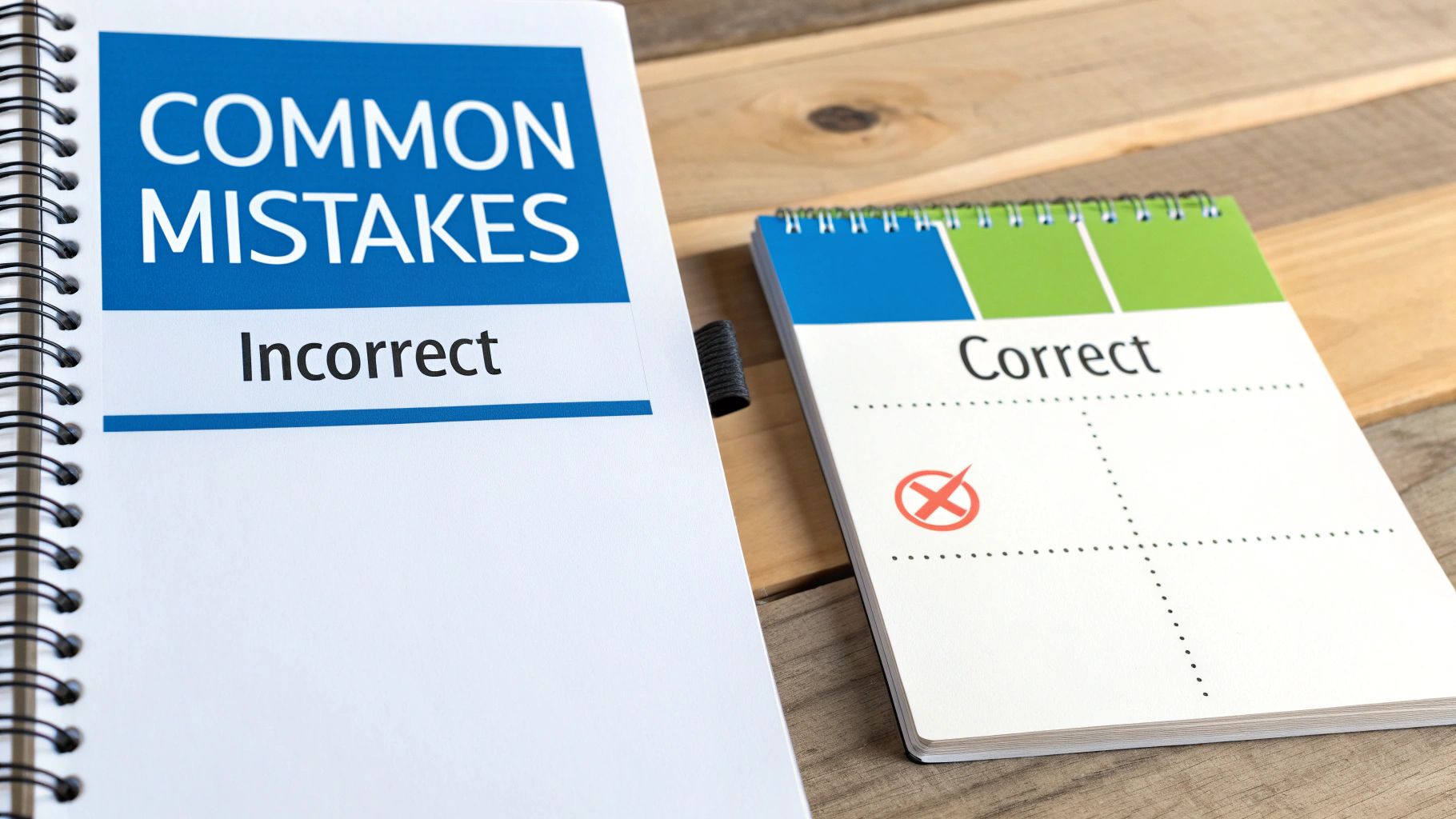Mastering the Compound Subject and Compound Predicate

At its heart, a compound subject is just a term for when two or more subjects share the same verb. On the other side, a compound predicate is when one subject is doing two or more things. Getting this simple difference down is the first step to making your sentences more detailed and less choppy.
Breaking Down Your Sentences
Every complete sentence, no matter how involved, is built from two basic parts: a subject and a predicate. Think of the subject as the main character—the "who" or "what" the sentence is all about. The predicate is everything else; it’s the "what they did" part, containing the action (the verb) and all the details that follow.
Take a simple sentence: "The dog barked." In this case, The dog is our subject, and barked is the predicate. Easy enough, right? Now, let's start adding more pieces to make things interesting.
What Is a Compound Subject?
You have a compound subject on your hands anytime two or more subjects are joined together (usually with words like and, or, or nor) to perform the very same action. Picture a band with two lead singers sharing one microphone—they're both doing the same thing.
Analogy: The guitarist and the drummer took the stage.
Here, "The guitarist" and "the drummer" team up to form a compound subject. Both are doing the exact same thing: taking the stage. Instead of writing two clunky sentences ("The guitarist took the stage. The drummer took the stage."), we get one smooth, connected idea.
What Is a Compound Predicate?
A compound predicate is simply the reverse. It’s where one single subject performs two or more separate actions, which are also connected by a conjunction. Think of a multitasking chef who's juggling multiple tasks at once.
- Example: The chef chopped the vegetables and stirred the soup.
- Subject: The chef (just one person)
- Actions: "chopped the vegetables" and "stirred the soup"
In this example, our single subject is linked to a compound predicate that packs in multiple actions. This structure is a great way to add more detail and energy to your writing without sounding repetitive.
These ideas aren't some new-fangled grammar trend; they've been fundamental to English for well over a century. In fact, large-scale studies of written English have found that sentences with a compound subject make up around 8-12% of all complex sentences. Similarly, compound predicates show up in about 10% of sentences in academic and literary writing. If you're curious, you can read more about the historical context and usage of these structures.
Ultimately, mastering both the compound subject and compound predicate is one of the most straightforward ways to make your writing more vivid and engaging.
How to Properly Use Compound Subjects
Compound subjects are a simple but effective way to make your writing flow better and sound more natural. Instead of stringing together short, choppy sentences, you can link multiple subjects using a connecting word, also known as a conjunction. The usual suspects here are and, or, and nor.
This technique lets you combine fragmented ideas into a single, cohesive thought. It’s the difference between writing, "The dog is sleeping. The cat is sleeping," and the much smoother, "The dog and the cat are sleeping." It just sounds better.
The Golden Rule: Subject-Verb Agreement
The number one rule to remember when you're working with compound subjects is subject-verb agreement. This just means that the verb in your sentence needs to match the number of subjects you're using. It’s a common little tripwire, but the rules are pretty straightforward once you get the hang of them.
When your subjects are connected by and, you treat them as a plural group. That means you need to use a plural verb.
- Incorrect: Maria and her brother is going to the park.
- Correct: Maria and her brother are going to the park.
Simple, right? Since there are two subjects ("Maria" and "her brother"), the verb has to be plural ("are") to match. This is the kind of compound subject you'll run into most often.
Navigating 'Or' and 'Nor'
Now, things get a little trickier when you bring in the conjunctions or or nor. With these words, the verb doesn't agree with the subjects as a combined unit. Instead, it only agrees with the subject that's physically closest to it in the sentence. This is called the proximity rule.
Let’s see how it works with "or":
- Either the students or the teacher has the key.
In this sentence, "teacher" is a singular noun, and it's right next to the verb. So, the verb has to be singular ("has") to match. But watch what happens when we flip the subjects around:
- Either the teacher or the students have the key.
Now the plural noun "students" is closer, so the verb becomes plural ("have"). The exact same logic applies when you're using "nor."
To make this clearer, let's break down a few examples.
Identifying Compound Subjects and Conjunctions
The table below shows how different subjects connect with conjunctions to share a single action or state of being.
| Sentence | Subject 1 | Conjunction | Subject 2 | Shared Predicate |
|---|---|---|---|---|
| Pancakes and syrup are a classic breakfast. | Pancakes | and | syrup | are a classic breakfast |
| My mom or my dad will pick you up. | My mom | or | my dad | will pick you up |
| Neither the book nor the movie was very good. | the book | nor | the movie | was very good |
| You and I need to talk. | You | and | I | need to talk |
This visual breakdown helps you see exactly how the parts of the sentence fit together and why the verb choices are so important.
Key Takeaway: For subjects joined by 'and,' always use a plural verb. For subjects joined by 'or' or 'nor,' make the verb agree with the subject positioned nearest to it.
Getting this right is a huge step toward writing clean, grammatically sound sentences. It might feel a bit awkward at first, but with a little practice, it'll become second nature. For anyone looking to polish their writing and catch these kinds of errors, using a tool like Word Spinner can be a real help. Its rewriting abilities help make sure your content sounds natural and is free from mistakes.
Adding Action with Compound Predicates
We’ve seen how multiple subjects can team up to perform a single action. Now, let’s flip the script. A compound predicate is the other side of that coin: one single subject performing two or more actions.
This structure is a powerhouse for packing more detail and energy into a single, lively sentence.
Think about it. You could write two simple sentences: "The hero fought bravely. The hero won the battle." They’re fine, but a little flat. Combining them creates something much more efficient and powerful: "The hero fought bravely and won the battle." The subject ("The hero") stays the same, but the predicate now juggles two distinct actions connected by and.
Using compound predicates makes your writing more descriptive and helps the narrative flow smoothly by showing a clear link between actions. This is a core part of learning how to show and not tell when writing, as it helps you paint a much more vivid picture for your reader.
Keeping Your Verbs Consistent
One of the golden rules of using a compound subject and compound predicate is to maintain parallel structure. It sounds technical, but the idea is simple: all the verbs in your predicate need to be in the same tense or form. This consistency is what makes the sentence sound balanced and polished.
When your verbs don't match, the sentence can feel clunky and just plain wrong.
- Incorrect: The dog chased the ball and is bringing it back.
- Correct: The dog chased the ball and brought it back.
In the correct version, both "chased" and "brought" are in the simple past tense, creating a logical sequence of events. Keeping your verb forms parallel is a mark of strong, clear writing.
Examples of Compound Predicates in Action
Let's see how this works in a few different contexts. A compound predicate can easily link two, three, or even more actions together.
- The student researched the topic, wrote the essay, and submitted it before the deadline. (Three actions)
- The chef will prepare the ingredients, cook the meal, and plate the final dish. (Three actions, future tense)
- She neither called nor texted me all day. (Two actions connected with "nor")
Key Takeaway: A compound predicate lets one subject do multiple things in a single sentence. To make it work, you have to ensure all the verbs follow a parallel structure—meaning they all share the same grammatical form.
Pro writers use this technique all the time to give their writing a more interesting rhythm and flow. For anyone looking to add more sentence variety and make their writing sound more natural, a tool like Word Spinner can be a huge help. It can suggest different ways to phrase your ideas, making your text more lively while checking for grammatical consistency.
Take Your Writing to a New Level
Understanding how to use a compound subject and compound predicate isn't just a boring grammar lesson—it's one of the fastest ways to improve your writing. These structures are the secret to turning short, clunky sentences into prose that flows smoothly and keeps your reader interested.
Think about it. Which one sounds better?
- Choppy: Maria went to the store. She bought milk.
- Smooth: Maria went to the store and bought milk.
The second version just works. By using a compound predicate, it links related ideas together in a single, fluid thought. This makes your writing feel more natural and professional, whether you're drafting an important email, a company report, or a school paper.
From Rules to Results
Getting a handle on these structures is a practical step toward becoming a more confident and persuasive writer. In fact, many education systems see the ability to build complex sentences as a major achievement in a student's literacy.
Research shows a clear link between understanding these structures and scoring higher on reading and writing tests. For instance, in school systems with a strong focus on grammar, 75-85% of students are using these forms correctly by the time they hit middle school, which gives their language skills a huge boost. You can discover more about how compound predicates are taught to see how this plays out in the classroom.
At the end of the day, this isn't just some rule to memorize for a quiz. It’s a core technique for better communication. Knowing how to combine ideas shows you can think logically and express yourself with polish. If you're ready to keep improving, check out our other tips to improve English writing skills.
Key Insight: Using compound subjects and predicates is one of the most efficient ways to eliminate repetition and add a sophisticated rhythm to your writing. It shows you can connect ideas logically.
The best way to make these tools a natural part of your writing is to practice. A great way to start is to engage with writing prompts for 5th grade—they're designed to spark creativity and help you experiment with sentence structures in a fun, low-pressure way.
Common Mistakes and How to Avoid Them
Even after you get the hang of the basics, a few common slip-ups can trip up even the best writers. While the rules for a compound subject and compound predicate are mostly straightforward, knowing where the tricky spots are can save you a ton of editing headaches later on.
Two of the biggest culprits are subject-verb agreement—especially when or and nor enter the scene—and faulty parallelism. Faulty parallelism is a fancy way of saying the verbs in a compound predicate don't match, making the sentence sound clunky and unbalanced.
Mismatched Verbs in Compound Subjects
The biggest hurdle with compound subjects is picking the right verb. While and almost always signals a plural verb, the words or and nor play by a different rule: the proximity rule. This just means the verb agrees with whichever part of the subject is physically closer to it in the sentence.
- Incorrect: Neither the players nor the coach were happy with the result.
- Correct: Neither the players nor the coach was happy with the result.
See what happened there? The singular subject "coach" is right next to the verb, so the verb has to be singular, too ("was"). If you were to flip the subjects around, the verb would change to "were" to match "players." It's all about proximity.
Faulty Parallelism in Compound Predicates
When you're dealing with compound predicates, consistency is everything. All the actions the subject is performing should be in the same verb tense or form. This idea is known as parallel structure, and when it’s missing, your sentences just feel… off.
Key Takeaway: Make sure all verbs in a compound predicate share the same grammatical form. This keeps your sentences balanced and easy to read.
Let's look at an example:
- Incorrect: She researched the topic and is writing her paper.
- Correct: She researched the topic and wrote her paper.
The fix is simple: just make sure "researched" and "wrote" are both in the past tense. It's a small tweak, but it makes a huge difference in clarity and flow.
Unnecessary Commas
One last common mistake is dropping a comma where it doesn’t belong. If a single subject has a compound predicate with just two verbs, you do not need a comma before the conjunction.
- Incorrect: The dog ran outside, and chased the squirrel.
- Correct: The dog ran outside and chased the squirrel.
Save your commas for separating two complete sentences (independent clauses) or when you're listing three or more items.
To help you spot these issues in your own writing, here’s a quick-reference table.
Common Errors and Simple Fixes
| Common Mistake | Incorrect Example | Correct Example | Simple Rule to Remember |
|---|---|---|---|
| Verb Agreement with Or/Nor | The cat or the dogs is making that noise. | The cat or the dogs are making that noise. | The verb agrees with the subject closest to it. |
| Faulty Parallelism | He likes running, swimming, and to hike. | He likes running, swimming, and hiking. | Keep all verbs in the same form (e.g., all -ing words). |
| Extra Commas | She painted the fence, and mowed the lawn. | She painted the fence and mowed the lawn. | Don't use a comma with only two verbs in a predicate. |
Correcting these small errors is one of the fastest ways to level up your work. As you keep practicing, these rules will become second nature. To keep sharpening your craft, you can always explore more tips to improve writing skills and become a more confident communicator.
Where These Structures Pop Up in Everyday Life
The ideas of a compound subject and compound predicate might sound like they belong in a dusty old grammar book, but they’re actually all over the place in modern writing. You’ll find these structures in everything from quick text messages and social media posts to professional emails and blog articles. They aren't just obscure rules; they're practical tools we use every single day.
Just think about platforms like X (formerly Twitter), where every character is precious. The drive for brevity makes a compound predicate the perfect solution for saying more with less. Instead of sending two separate posts, a user can simply write, "Just finished my workout and grabbed a coffee," packing two distinct actions into one clean, concise update.
Grammar in the Digital Age
This shift toward efficiency isn't just a hunch—it's a real, measurable trend in how we communicate online. As our conversations have gotten faster and more frequent, these compact grammatical forms have naturally become more popular.
Research into digital communication patterns reveals a noticeable increase in the use of compound predicates in online writing. One analysis found that roughly 18-22% of English tweets contain a compound predicate, which helps users share multiple actions within strict character limits. While not as common, compound subjects still show up in about 7-9% of posts to quickly group several people or things together. To see more on this linguistic evolution, you can explore detailed insights into modern language usage.
This data really drives home the point: knowing how to use a compound subject and compound predicate is more useful now than ever before.
Polishing Your Everyday Writing
Getting a handle on these structures is a direct benefit for anyone who writes online. It helps you produce clean, polished text more efficiently, which is a huge advantage for everything from crafting the perfect email to writing engaging content.
The right sentence structure ensures your message lands with clarity and impact. Understanding the different types of diction can also help you fine-tune your tone for any audience. At the end of the day, these grammar tools are all about making your communication sharper and more effective, no matter the context.
Frequently Asked Questions
Even after you get the rules down, a few tricky questions tend to trip people up. This section is designed to give you quick, clear answers to the most common sticking points with compound subjects and compound predicates.
Think of it as your go-to guide for clearing up any last bit of confusion.
Can a Sentence Have Both a Compound Subject and a Compound Predicate?
Yes, it absolutely can. A sentence can easily have multiple subjects performing multiple actions. This structure is actually a great way to pack a ton of information into one clean, efficient statement.
For example, take this sentence: "The team and the coaches planned the strategy and won the game."
Here, "The team and the coaches" is our compound subject, and "planned the strategy and won the game" is the compound predicate. See how it all fits together?
How Do I Pick the Right Verb for Subjects Joined by Or or Nor?
This is a classic grammar hurdle, but the rule is surprisingly simple: the verb must agree with the subject closest to it. This is sometimes called the proximity rule.
Let's look at an example: "Neither the manager nor the employees are happy." The verb "are" is plural because its closest subject, "employees," is plural.
Now, let's flip it around: "Neither the employees nor the manager is happy." The verb switches to the singular "is" to match the closer subject, "manager." Easy, right?
Do I Always Need a Comma Before And in a Compound Predicate?
Most of the time, the answer is no. You typically do not need a comma when you only have two actions in the predicate. A sentence like, "She wrote and mailed the letter," is perfectly fine without one.
Commas usually come into play when you're joining two complete sentences with a conjunction. The big exception here is when you have a list of three or more actions in the predicate. In that case, you'll want to use commas to separate them for clarity. For instance: "He cooked, cleaned, and relaxed."
Creating clear, grammatically sound sentences is much easier when you have the right tools in your corner. Word Spinner offers rewriting capabilities that can help you refine your sentence structures, humanize your content, and make sure your final text is 100% original and error-free. Explore how Word Spinner can improve your writing.



